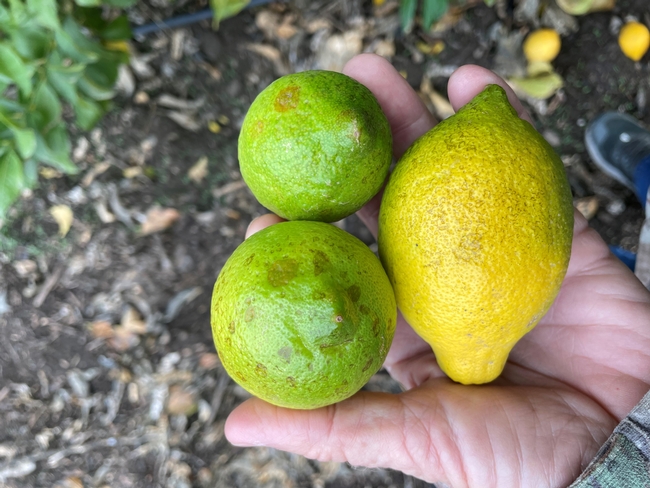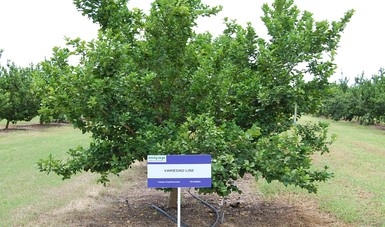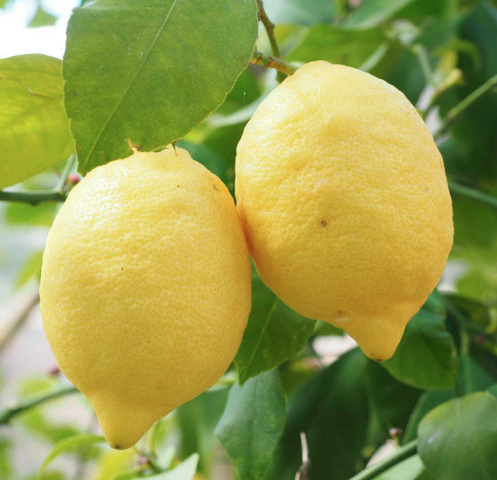
Posts Tagged: lemon
Lemons and Oil and Water Spots
A recent call came through inquiring about the cause of “water spotting” or "staining" on lemons from a coastal orchard. The orchard was sprayed for pests using a horticultural oil in October and at harvest, the spotting was noted. The guidelines for oil use are to avoid use when temperatures exceed 90 deg or so and when it gets cold or is forecast to get cold. The cold injunction is because that fruit mass causes condensation which leads to the spotting. It should never be used when frost is forecast either. The problem along the coast is the weather is about as fickle as weather can get anywhere in the state. Hot one day and cold the next. You can break the rules 9 out of 10 times and get away with it, but according to our Advisor Craig Kallsen in Kern, you get caught the one time when you break the rule.
Oil sprays are an important component in citrus IPM programs for the control of armored and soft scales, aphids, leafminers, and certain species of mites. When used alone, they may be applied using outside coverage (OC) for aphids, leafminers or mites, intermediate coverage (IC) if used for soft scales, and thorough coverage (TC) if used for armored scales at rates of 1 to 6% depending on the crop, time of year and the target pest. Oils are frequently used at rates of 0.25 to 1% in combination with other insecticides. Because petroleum oils can cause phytotoxicity, the following precautions are important:
- Soil moisture should be maximum before application; spray as soon after an irrigation as the ground will permit operation of the equipment. Be sure to maintain adequate soil moisture from spring throughout the entire irrigation season.
- Do not spray oils when temperatures exceed 95°F or relative humidity falls to 20% or below (in coastal regions, do not spray if the temperature will exceed 85° to 90°F or the relative humidity goes below 30%); also do not use oil sprays immediately before, during, or following an unusually cold weather period.
- Problems of leaf drop and fruit drop can be minimized, in general, by adding 2,4-D to the oil spray mixture. Be careful not to apply 2,4-D within 2 miles of sensitive crops such as tomatoes, cotton, olives, and grapes and do not use 2,4-D during spring to avoid phytotoxicity problems.
- If navel orange orchards are sprayed with oil when oranges are approaching maturity, generally from November until harvest, protection against water spot may be obtained by using gibberellic acid. (Caution: fall oil sprays may increase the risk of damage caused by frost).
- Complete coverage of the tree with an oil spray provides more effective control than increased dosage. If spraying is done by ground, equip the rig with a tower capable of elevating a sprayer 4 feet above the tallest trees.
- Generally, narrow range oils with a 50% distillation range of 415 to 455 are recommended for use in citrus.
- The heavier the oil is (e.g., NR 440 is heavier than NR 415), the better its insecticidal properties will be, but also the greater the potential for phytotoxicity to the tree.
Precautions for Using Petroleum Oil Sprays from UC Integrated Pest Management website

lemon oil spray damage
Citrus Webinar Series
The Citrus Research Board (CRB), in coordination with the University of California Statewide Integrated Pest Management Program (UC IPM), will hold the first and second webinars of the 2021 CRB Webinar Series on Tuesday, June 1, 2021, and Tuesday, June 8, 2021.
One hour of continuing education units through the California Department of Pesticide Regulation (CDPR) is pending and available for those in attendance at each webinar.
The series will kick-off on Tuesday, June 1, 2021, with Dr. Greg Douhan, Area Citrus Advisor for Cooperative Extension Tulare County, providing an update to the industry. He will be followed by Mandy Zito, Deputy Agricultural Commissioner/Sealer for Fresno County Department of Agriculture, who will cover laws and regulations pertaining to pesticides, pest control operations, and worker safety that have gone into effect since 2017.
This webinar is approved for 1-hour of “Laws and Regulations” continuing education units from the California Department of Pesticide Regulation (CDPR) and Certified Crop Advisor (CCA).
Click Here to Register for the June 1 Webinar >
On Tuesday, June 8, 2021, Sonia Rios, Area Subtropical Horticulture Advisor for Cooperative Extension Riverside County, will provide an update to the industry. She will be followed by Dr. Sandipa Gautam, Assistant Research Entomologist at the UC Kearney Agricultural Center, who will cover various topics in citrus IPM. She will cover basic California redscale biology and information about selecting insecticides for organic and conventional treatment for Asian citrus psyllid as well as ants and thrips.
This webinar is approved for 1-hour of “Other” continuing education units from the California Department of Pesticide Regulation (CDPR) and Certified Crop Advisor (CCA).
Click Here to Register for the June 8 Webinar >
On Tuesday, June 15, 2021, Dr. Ben Faber, Regional Farm Advisor for Cooperative Extension Ventura County, will provide an update to the industry. He will be followed by Casey Creamer, President/CEO of California Citrus Mutual, and Austin Ewell, Executive Director of Blueprint. They will discuss the current state of affairs of surrounding California water, activities of the Water Blueprint, and thoughts on how the citrus industry is positioned to deal with the Sustainable Groundwater Management Act.
This webinar is approved for 1-hour of “Other” continuing education units from Certified Crop Advisor (CCA).
Click Here to Register for the June 15 Webinar >
On Tuesday, June 22, 2021, Cindy Fake, Regional Farm Advisor for Cooperative Extension Placer and Nevada Counties, will provide an update to the industry. She will be followed by Dr. Tracy Kahn and Dr. Mike Roose, who will share an update on the results of the multi-location lemon scion and rootstock trials. This will include tree health, tree size, yield per tree and packline data on fruit characteristics.
This webinar is approved for 1-hour of “Other” continuing education units from Certified Crop Advisor (CCA).
Click Here to Register for the June 22 Webinar >

lemons
A New Lemon in Town
Agriculture develops a new variety of lemon, which offers greater yield and adaptation for the benefit of producers in Colima and Michoacán
Experts from the Fruit Research Program of the National Institute for Forestry, Agricultural and Livestock Research (INIFAP) generated the LISE, a citrus fruit that offers better attributes and increases the diversity in quality lemons.
It's interesting how in this age of ACP and HLB, conventional citrus varieties are being developed and released. There's a lot more breeding done to find HLB resistant/tolerant selections. Maybe the idea here, is that "lemons" have a tendency towards more resistance than sweet oranges. Not as much as finger limes, but maybe this does so well in Colima that it would be hard not to plant it.
It stands out because its skin is thin, with a smooth surface, leaves of a darker green color than Colimex, contains three to five seeds, has a soft yellowish-green pulp and has nine to 12 segments and between 44 to 48 percent of acid juice.
- Experts from the Fruit Research Program of the National Institute for Forestry, Agricultural and Livestock Research (INIFAP) generated the LISE, a citrus fruit that offers better attributes and increases the diversity in quality lemons.
- It stands out because its skin is thin, with a smooth surface, leaves of a darker green color than Colimex, contains three to five seeds, has a soft yellowish-green pulp and has nine to 12 segments and between 44 to 48 percent of acid juice.
As part of the actions of the Ministry of Agriculture and Rural Development to promote and strengthen citrus producers in Mexico, the National Institute for Forestry, Agricultural and Livestock Research (INIFAP) developed the LISE variety, a Mexican lemon with high yield. better characteristics and high adaptation to producing areas in Colima and Michoacán.
Specialists from the Research Program in Fruit Trees of the Tecomán Experimental Field of INIFAP selected lemon plants with outstanding agronomic qualities and generated the "Lise", a variety that has better attributes and increases the diversity in quality citrus fruits, indicated the Institute.
The federal agency highlighted that the lemon tree blooms several times a year, with greater intensity from January to March, and is characterized by its flower buds having short petals, its fruit production extends throughout the year and its richest harvests are They get from May to September.
The skin of LISE is thin with a smooth surface, has darker green leaves than Colimex, contains three to five seeds, is soft pulp, has nine to 12 segments and produces between 44 to 48 percent juice. acid.
This new variety is the result of two cycles of selection carried out on a natural variant that did not develop thorns, through natural crosses that take into account the selections in commercial Mexican lemon plantations in Colima, explained INIFAP.
He pointed out that, according to the records of the Institute's specialists, a year yields greater than 35 tons per hectare are obtained without the presence of the citrus disease: Huanglongbing (HLB).
INIFAP specialists recommend, for practicality and economy, planting it in the rainy season in loamy soils and establishing it at a distance of six by four meters, pruning it annually, removing suckers (vegetative shoots) from the stem every three or four months and pointing the branches. long and slightly branched every six months to obtain more compact crowns.
INIFAP - a decentralized body of the Ministry of Agriculture and Rural Development - has a technological package with which it is expected that producers will obtain better yields and provides training to transfer knowledge on different varieties of lemon.

Lise lemon
Capturing Carbon in a Lemon Orchard
In honor of #HealthySoilsWeek2020, our healthy team would like to share background and an update on our healthy soils project @Limoneira in Santa Paula. Our group of researchers and advocates at @VenturaCountyResources Conservation District @UC Cooperative Extension and @Community Environmental Council are studying the climate, water and soil impacts of @Agromin mulch and compost on a new lemon orchard.
Hoping for better days, instead of a field day this year, we hope you enjoy this video to learn more about this project. We are only about halfway through the project, so stay tuned for more results next year!
This project was funded through the Healthy Soils Project at the California Department of Food and Agriculture. CDFA's Healthy Soils Program includes 643 projects totaling more than $42.2 million in grants funds. These projects cover almost 60,000 acres and will sequester more than 112,000 metric tons of CO2e, which is equivalent to removing 24,250 cars from the road each year.

mulch
Production Cost Study for Coastal Lemons
A new study on the costs and returns of establishing and producing lemons in Ventura County has been released by UC Cooperative Extension in Southern California and UC Agricultural Issues Center, both part of UC Agriculture and Natural Resources.
“Coastal agriculture is always in transition and as strawberries and vegetables become less profitable due to markets and labor availability, lemons have returned as a potentially profitable alternative to those crops,” saidBen Faber, UC Cooperative Extension farm advisor for Ventura County and coauthor of the study.
California lemon acreage was at roughly 47,000 acres in 2018-19, of which Ventura County accounts for 31%, according to the 2019 Ventura County Crop Report. Ventura County was growing lemons on 14,407 acres in 2019.
“The profitability of lemon production depends on the price of land,” said Etaferahu Takele, UC Cooperative Extension farm management advisor for Southern California, another coauthor of the study. “If the price of land continues in its current trend, it could be prohibitive for new entrants to make a profit and limit further expansion of lemon production in the county.”
Their cost analysis describes production operations for Eureka lemons on macrophylla rootstock, which are planted at 155 trees per acre with an expected life span of 40 years.
The study includes a detailed summary of costs and returns and a profitability analysis of gross margin, economic profit and a break-even ranging analysis table, which shows profits over a range of prices and yields.
Input and reviews were provided by Ventura County farm advisor and grower cooperators. The authors describe the assumptions used to identify current costs for lemon establishment and production, material inputs, cash and non-cash overhead.
The new study, “2020 - Sample Costs to Establish and Produce Eureka Lemons in Ventura County,” can be downloaded for free from the UC Davis Department of Agricultural and Resource Economics website at http://coststudies.ucdavis.edu and the UCCE Riverside County Farm Management website at https://ucanr.edu/sites/Farm_Management/files/338947.pdf. Sample cost of production studies for many other commodities are also available on the websites.
For additional information or an explanation of the calculations used in the studies, refer to the section of the report titled “Assumptions” or contact Takele at (951) 683-6491 Ext. 243 ettakele@ucanr.edu or Donald Stewart at the UC Agricultural Issues Center at (530) 752-4651, destewart@ucdavis.edu.
For information about production of lemons in Ventura County, contact Faber at bafaber@ucanr.edu.
Lemon Orchard - Edward Okun

lemon orchard Edward Okun

